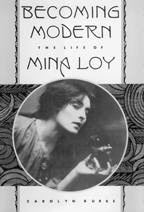Ms. Mod
Thanks to local author Carolyn Burke, '30s rebel reigns again
Reviewed by Sarah Phelan
Who in the world is Mina Loy? Hardly a household name today, this dark-haired beauty of Anglo-Jewish descent was once internationally notorious as a writer of shocking free verse. When she sailed into New York Harbor on a steamboat from Europe back in 1916, her scandalous reputation had already preceded her.
Despite her elegant dresses and dangly earrings, Mina was a feminist before the term was even coined, and she tackled everything in her poetry from menstruation and childbirth to suicide and prostitution with such startling honesty and breathtaking imagery that even the ornery Ezra Pound declared himself impressed.
London, Paris, Rome, New York--each provided a harbor for Loy. But though she moved among such big-name modernists as Gertrude Stein, James Joyce, Marcel Duchamp and Man Ray, she vanished abruptly from this landscape of luminaries in the 1930s to become the missing person of modernism.
But she's missing no longer. Like some reassembled exotic butterfly, Loy has been recovered in all her multifaceted glory by Carolyn Burke. The Santa Cruz writer first became obsessed with the thoroughly modern Mina during the '70s, when Loy's name kept popping up in the biographies of everyone from Ernest Hemingway to Marianne Moore.
Always making brief but brilliant appearances at wild parties or as somebody's mistress, Loy somehow remained slightly out of focus, leaving Burke with little more than the confusing reflection from hundreds of tantalizing bits of information about this dazzling woman. Undeterred by this daunting task, Burke spent the next 15 years piecing together Becoming Modern: The Life of Mina Loy, her exhaustively researched and beautifully written biography of Loy, in which she cleverly manipulates both the language and imagery to mirror Mina's progression through her anti-career.
Was Loy an innovative poet with her roots in art, or a painter who branched into language? A militant or a pacifist? A mother or a self-absorbed artist? In truth, Loy followed no one path, her life filled with contradictions and counter-allegiances. In America, she turned her back on the discriminatory British class system, while happily assuming the elitist position of an expatriate modernist. In Mexico, she lost the love of her life, boxer-poet Arthur Craven, to a death by drowning, even as her deeper social consciousness was born. In Aspen, she spent her final years with her disapproving daughters, whom she embarrassed horribly by befriending the homeless and building decorative assemblages out of eggshells, broken bottles and other junk collected off the street.
Burke believes that Loy lived her "spiritual zigzags in full awareness of her contradictions, and that she cherished them as facets of her genius." And while she may not have been recognized as a genius by her peers, Loy stands out as the poetic consciousness of her time. Its "cartographer of the imagination," she was a visionary poet who mapped out the challenges that wildly independent women still face today.
[ Santa Cruz | MetroActive Central | Archives ]
This page was designed and created by the Boulevards team.

Becoming Modern
By Carolyn Burke
Farrar, Straus and Giroux; 493 pages; $35
From the August 29-Sepetember 4, 1996 issue of Metro Santa Cruz
Copyright © 1996 Metro Publishing, Inc.
![[MetroActive Books]](/gifs/books.gif)